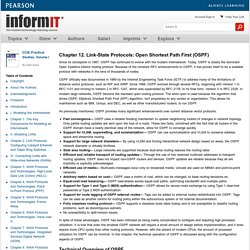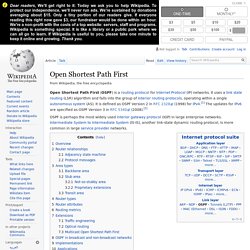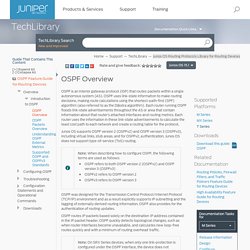

OSPF Designated Router Overview - TechLibrary. Large LANs that have many routing devices and therefore many OSPF adjacencies can produce heavy control-packet traffic as link-state advertisements (LSAs) are flooded across the network.

To alleviate the potential traffic problem, OSPF uses designated routers on all multiaccess networks (broadcast and nonbroadcast multiaccess [NBMA] networks types). Rather than broadcasting LSAs to all their OSPF neighbors, the routing devices send their LSAs to the designated router. Each multiaccess network has a designated router, which performs two main functions: Originate network link advertisements on behalf of the network.Establish adjacencies with all routing devices on the network, thus participating in the synchronizing of the link-state databases.
OSPF Designated Router Overview - TechLibrary. Areas and Area Border Routers - J-series™ Services Router Basic LAN and WAN Access Configuration Guide. [ Contents] [ Prev] [ Next] [ Index] [ Report an Error] The OSPF networks in an AS are administratively grouped into areas.

Each area within an AS operates like an independent network and has a unique 32-bit area ID, which functions like a network address. Within an area, the topology database contains only information about the area, LSAs are flooded only to nodes within the area, and routes are computed only within the area. Subnetworks are divided into other areas, which are connected to form the whole of the main network. The central area of an AS, called the backbone area, has a special function and is always assigned the area ID 0.0.0.0. Link-state advertisement. The link-state advertisement (LSA) is a basic communication means of the OSPF routing protocol for the Internet Protocol (IP).

It communicates the router's local routing topology to all other local routers in the same OSPF area. OSPF is designed for scalability, so some LSAs are not flooded out on all interfaces, but only on those that belong to the appropriate area. In this way detailed information can be kept localized, while summary information is flooded to the rest of the network. The CCNA Candidate’s Guide to OSPF : OSPF DR & BDR : Part 1. OSPF Area Types. CCNA R&S Exam Course. CCNA R&S Exam Course. Lsa type at DuckDuckGo. Open Shortest Path First (OSPF) CCNA R&S Exam Course. Chapter 12. Link-State Protocols: Open Shortest Path First (OSPF) Chapter 12.

Link-State Protocols: Open Shortest Path First (OSPF) Since its conception in 1987, OSPF has continued to evolve with the modern internetwork. Today, OSPF is clearly the dominant Open Systems interior routing protocol. Because of the constant RFC enhancements to OSPF, it has proven itself to be a scalable protocol with networks in the tens of thousands of nodes.
OSPF officially was documented in 1989 by the Internet Engineering Task Force (IETF) to address many of the limitations of distance vector protocols, such as RIP and IGRP. As previously mentioned, OSPF provides many significant enhancements over current distance vector protocols: Fast convergence— OSPF uses a reliable flooding mechanism to update neighboring routers of changes in network topology. In spite of these advantages, OSPF has been criticized as being overly complicated to configure and requiring high processor utilization. Fun with OSPF LSA Type 5, External Type 1. So maybe you're running around, getting last minute presents, trying to work a ton today so you can rest easy over the long weekend... and you need a break.

Coffee at the local Panera, whilst listening to even more Christmas carols? Stopping by holiday party leftovers in the conference room? Or how about refreshing your memory on how OSPF deals with External type 1 LSAs? For those of you opting for the latter, if you didn't do so already, check out the previous post on Type 5 external type 2 LSAs. Fun with OSPF LSA Type 5, External Type 1. Fun with OSPF LSA Type 5, External Type 1. Open Shortest Path First. OSPF is perhaps the most widely used interior gateway protocol (IGP) in large enterprise networks.

Intermediate System to Intermediate System (IS-IS), another link-state dynamic routing protocol, is more common in large service provider networks. Overview[edit] An OSPF network may be structured, or subdivided, into routing areas to simplify administration and optimize traffic and resource utilization. Areas are identified by 32-bit numbers, expressed either simply in decimal, or often in the same octet-based dot-decimal notation used for IPv4 addresses. By convention, area 0 (zero), or 0.0.0.0, represents the core or backbone area of an OSPF network. OSPF does not use a transport protocol, such as UDP or TCP, but encapsulates its data directly in IP packets with protocol number 89.
OSPF version 3 introduces modifications to the IPv4 implementation of the protocol.[2] Except for virtual links, all neighbor exchanges use IPv6 link-local addressing exclusively. OSPF Feature Guide for Routing Devices. OSPF is an interior gateway protocol (IGP) that routes packets within a single autonomous system (AS).

OSPF uses link-state information to make routing decisions, making route calculations using the shortest-path-first (SPF) algorithm (also referred to as the Dijkstra algorithm). Each router running OSPF floods link-state advertisements throughout the AS or area that contain information about that router’s attached interfaces and routing metrics. Each router uses the information in these link-state advertisements to calculate the least cost path to each network and create a routing table for the protocol.
Junos OS supports OSPF version 2 (OSPFv2) and OSPF version 3 (OSPFv3), including virtual links, stub areas, and for OSPFv2, authentication. Introduction to OSPF Part 1.